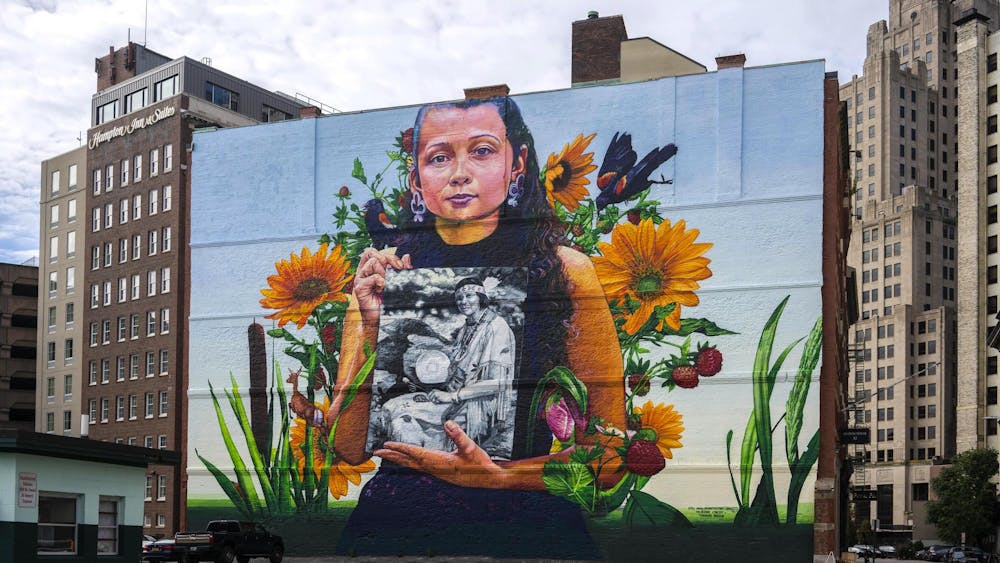On Friday, the Rhode Island School of Design hosted a celebration of the five-year anniversary of the mural “Still Here” in downtown Providence. The mural depicts Lynsea Montanari, a Narragansett woman and representative from the Tomaquag Indigenous Museum, holding a picture of Princess Red Wing, a “Narragansett/Pokanoket-Wampanoag elder, historian, folklorist and curator,” according to the event’s press release.
Held in the RISD auditorium, the event featured Gaia, the mural’s artist, Montanari and Lorén M. Spears, representatives from the Tomaquag Indigenous Museum, and Nick Platzer, senior mural program manager at The Avenue Concept.
Montanari opened the event with a land acknowledgment and preliminary remarks about the artwork
“As a Narragansett myself, I always find it interesting this idea of land acknowledgment … when all of the United States was Indigenous land,” she said. “Often in these moments, we are asked to acknowledge a specific and small location.”
Montanari explained that she feels that this land is sacred, but that people still take it for granted. “Providence so often walks over us and around us but rarely acknowledges that we exist,” she said.
“Most importantly, know that we’re still here,” she added, echoing the theme of the mural.
The project came about when TAC, an organization that works to support the creation and installation of public art, reached out to Gaia in 2018 to commission an 80-foot-tall wall in downtown Providence.
After hitting a block when devising ideas for the mural, Gaia refocused his attention on the concept of erasure, suggesting to TAC that they “collaborate with the local Indigenous people.”
The day before the scheduled date for the mural’s painting, Gaia called Spears to ask if the Tomaquag Museum wanted to collaborate on the project.
“We thought he was crazy,” Spears said. “But after a genuine conversation over what the purpose of this mural was, we agreed” to participate.
When Montanari got the call informing her that she had been chosen as a potential candidate for the mural’s subject and learned of Gaia’s intentions, Montanari said she consented under one condition: She did not want to wear Indigenous regalia in the photoshoot for the mural.
“Most of the time we don’t wear that,” Montanari explained. “And if we do, what people are going to see is Indigenous people from the past.”
Montanari said she still strived to be representative of her community by wearing a floral skirt with Narragansett art patterns and a pair of native beaded earrings.
Spears, who was initially apprehensive about having Gaia “represent Indigenous culture,” also talked about the collaborative process of representing the Indigenous community.
By depicting “a millennial holding a picture of (Princess Red Wing, who was) born in 1896,” Spears wanted the mural to be a modern and genuine representation of the Indigenous community. The mural depicts “flora and fauna, sunflower, strawberries and cattails, (which) are all important to our community,” she added.
Despite the short turnaround between deciding to collaborate with Gaia and the actual painting of the mural, Montanari said the collaboration felt “like magic.”
Koji Hellman, a first-year student at RISD, came to the panel because “Still Here” was the first art piece shown in her art history lecture. “When I first visited Providence and RISD two years ago, I was taking in the mural’s beauty but not appreciating the details like the meaning of the earrings,” Hellman said. “This panel helped me understand how (the artist) did not fall into the stereotype of representation.”
Professor of Anthropology Patricia Rubertone used “Still Here” as the cover of her book, “Native Providence: Memory, Community and Survivance in the Northeast." Rubertone said she was “struck by how quickly this mural came together and how different stakeholders work together.”
According to Platzer, the initial intent of “Still Here” was to depict “what Lynsea represents: a young, successful Indigenous individual who holds on to her past but is still here,” adding that viewers often want to focus specifically on Montanari as the subject of the mural.
Montanari echoed Platzer’s sentiment in the panel. “This mural is visibility for my people,” she said. “It helped people see Indigenous people in this community and others see Indigenous people in their community.”
Moving forward, Montanari hopes to “preserve the mural for as long as possible” to show that “as everyone is changing, (Indigenous people) are still remaining in this space.”
Rebecca Weng is a Senior Staff Writer for Arts and Culture. She is a sophomore from Guangzhou, China studying English and CS-Econ.





